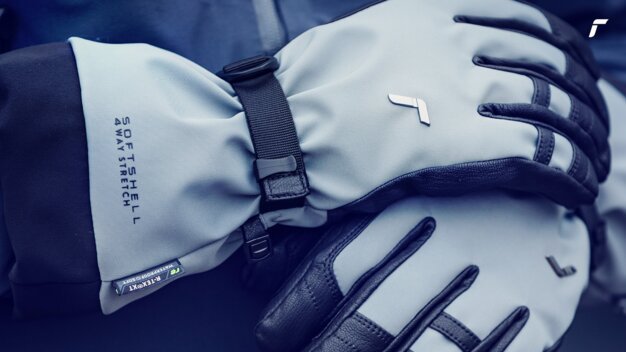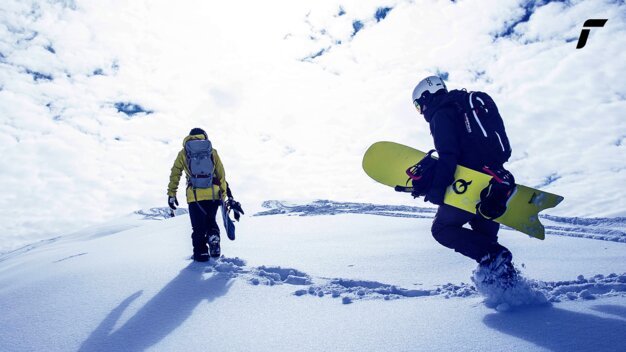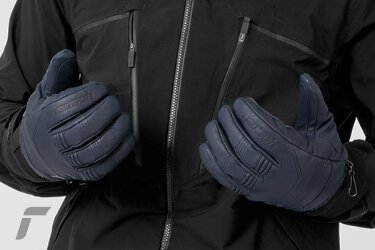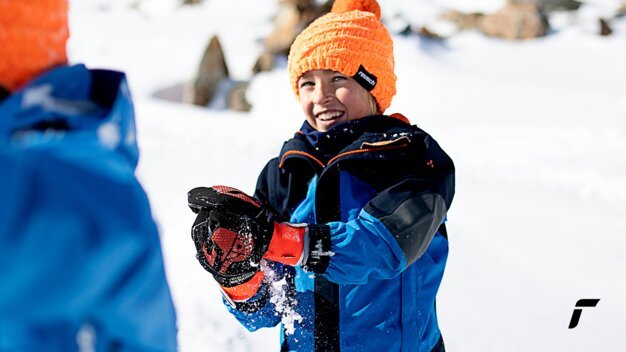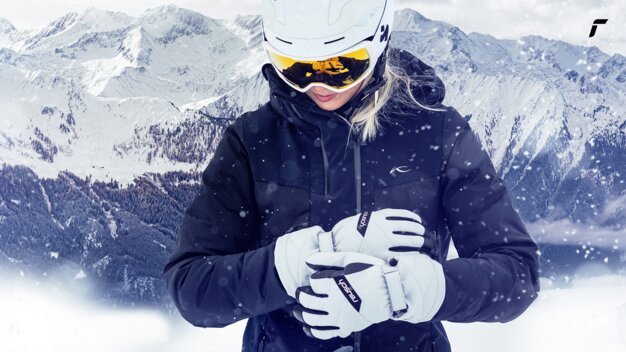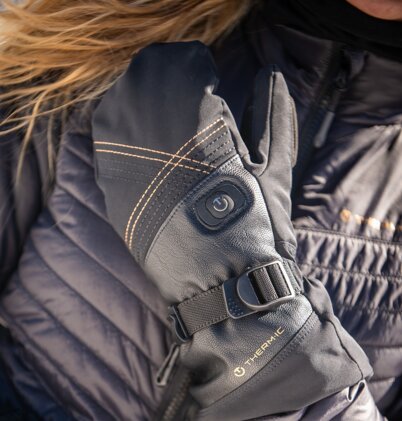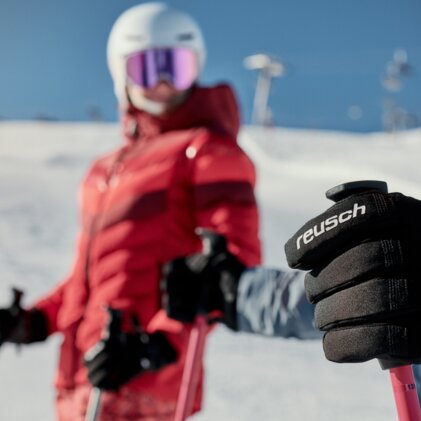
You've probably experienced this too: although you wear gloves in winter, your fingers are freezing cold. One reason for this is that your hands and feet are furthest away from the centre of your body - and are therefore unfortunately the first to feel the cold. The best ski gloves compensate for this by using high-quality materials and membranes. Thanks to high breathability and insulation, your fingers stay warm and nothing stands in the way of a long day on the slopes.
So that you don't have to cut your day on the mountain short because of cold hands, it's worth investing in good ski gloves or mittens. Find out now what is important when it comes to gloves and what features they should have.
How to recognise good ski gloves
Whether you're skiing, cross-country skiing or sledging: Good gloves are an essential part of any winter sports outfit. There are countless models out there - but which characteristics are worth the money?
What features characterise good ski gloves?
Good ski gloves or mittens are ...
... warm.
Logically, your body heat should stay inside the glove. That's why ski gloves should be well insulated.
... waterproof.
High-quality ski gloves are usually made of waterproof materials to keep your hands warm and dry.
... windproof.
The windproofness of a glove is an important criterion. Special materials ensure that your hands are optimally protected from cold air inside the glove.
... breathable.
Breathability is perhaps the most important quality feature of a good ski glove. It ensures that moisture and perspiration are quickly transported to the outside - keeping your hands pleasantly dry.
The weather also influences which properties your ski gloves should have. Are you usually on the mountain in low temperatures? Then it's more important that your gloves are warm rather than waterproof. Do you prefer mild temperatures on the slopes in spring? Then you should choose a lightweight model that won't make your hands sweat.
Our tip: If you get cold hands easily, it is of course better to choose a particularly warm glove or even heated ski gloves. If you tend to have warm hands, make sure that your gloves are particularly breathable to avoid sweaty fingers. Ski gloves also retain their characteristics for longer with the right care.
How do I find the perfect ski gloves for me?
To get the most out of your ski gloves, they should first and foremost fit perfectly. Choose a model that fits well but still gives you enough freedom of movement! Choosing the right size is essential. Because: if your gloves are too small, you risk cold fingers and models that are too big restrict your freedom of movement.
Most manufacturers offer size charts to help you find the perfect glove for your needs. To determine the right size, you should first measure your hands:
- Use a measuring tape or string.
- Measure the circumference of your hand at the widest point.
- Read the corresponding value from the tape measure or measure the string. Then look for the relevant information in the size chart.
Good to know: If you are between two sizes, simply choose the one that feels more comfortable - depending on whether you prefer a tighter or looser fit. Also remember that you may want to use inner gloves. In this case, you should choose a size larger.
And what about children's gloves? Especially for smaller children, glove sizes are not given according to size, but according to age.
Short or long cuff?
The cuff is the part of the ski glove that protects the wrist after the ball of the hand. The length you should choose depends on the intended use:
- For freeriders, long cuffs are definitely practical to prevent snow from getting into your gloves.
- For alpine skiing, we recommend gloves with short cuffs. They are the better choice for racing in particular due to their ergonomics and fit.
If you're riding with a rucksack, it's also a good idea to carry an extra pair. This way, you can react to changing temperatures or snowfall when the weather changes.
What materials and membranes make the best ski gloves?
The best ski gloves are characterised by high-quality materials and a well thought-out design. Models made from robust leather or hard-wearing synthetic textiles such as nylon or polyester are particularly popular. Leather scores with its high abrasion resistance and natural suppleness. In contrast to synthetic fibre models, however, they require regular care in order to remain waterproof and to prevent tears in the material. Synthetics, on the other hand, are easy to care for, dry quickly and are usually cheaper - ideal for a day on the slopes.
The right insulation, such as PrimaLoft®, ensures warm hands. These are very fine polyester microfibres that effectively store body heat and are easy to compress.
The outer layer, the membrane, provides the necessary protection from the weather. In most cases, as with Gore-Tex, these are thin layers that favour the transport of moisture from the inside to the outside. The small pores on the outer layer prevent water from getting inside. Depending on the type of membrane, the function is based either on a pressure gradient (Gore-Tex) or water-attracting or repelling layers (Sympatex, DryTech).
The warmest ski gloves
Mittens are among the warmest ski gloves. In comparison to normal models, in which each finger is individually wrapped, in these variants all the fingers, apart from the thumb, share a chamber. As all fingers are next to each other without a partition, they radiate more heat. This in turn is stored in the fibres of the insulation layer.
Ski gloves with separate chambers, on the other hand, are subject to more frequent temperature fluctuations from the outside. However, this comparison only makes sense if you assume the same materials and similarly high-quality workmanship.
Gloves or mittens for winter sports?
Both are a good choice for winter sports, and it's mainly a question of taste whether you prefer gloves or mittens. Both gloves have their right to exist and advantages and disadvantages. While mittens are warmer, they offer less freedom of movement. However, if you are snowboarding, you may be able to overlook this because you don't have to grip ski poles. On the other hand, if you often have to adjust your ski goggles or open and close zips on the slopes, you may prioritise mobility over warmth. So, the decision is entirely up to you.
Our tip: Three-finger mittens, also known as lobster mittens, offer the best of both worlds - warmth and freedom of movement.
Heated ski gloves
When conventional models reach their limits, heated ski gloves offer a comfortable solution - especially for particularly cold-sensitive hands or long days in sub-zero temperatures. Thanks to integrated heating systems, which are powered by a rechargeable battery or heating pad, they provide even heat at the touch of a button. Depending on the model, the degree of heat can also be regulated over several levels on models with a rechargeable battery. This is a real advantage, especially at very low temperatures, on longer lift journeys or for people with poor circulation.
However, heated gloves also have disadvantages: they are more expensive than conventional models, somewhat heavier and require regular recharging of the batteries. The technology is also susceptible to extreme moisture or mechanical stress. Furthermore, those who are often out and about in harsh conditions and value maximum comfort, heated gloves are a worthwhile investment.
Frequently asked questions about the best ski gloves
Are mittens good for skiing?
Mittens are just as good for skiing as "normal" ski gloves, where each finger is individually wrapped. They are generally considered warmer, but offer less freedom of movement. If you prioritise warmth, you will find great models among the mittens. And if you often find yourself adjusting your goggles, opening and closing zips or reaching into your rucksack, you are probably better off with conventional ski gloves.
What size for ski gloves?
When choosing the size, make sure that it fits perfectly on both the palm and the fingers. Too much or too little space has a negative effect on the warmth inside and protection from the weather. Use our size chart or, if you are unsure, ask our RENTertainers in one of our shops for advice.
Should ski gloves be waterproof?
Ski gloves should always be waterproof. Models labelled as such usually have a special membrane (Gore-Tex, Sympatex, DryTech) which prevents water from getting into the glove while moisture is transported from the inside to the outside. When choosing gloves, avoid simple cotton gloves or knitted versions made from other natural textiles. They offer neither the protection from the weather nor the breathability needed to guarantee your safety on the mountain.
INTERSPORT Rent Tip
The RENTertainer recommends
The best ski glove is the one that fits your proportions and doesn't hinder you during winter sports - regardless of whether it's a conventional glove or a mitten. If you are unsure about which model is suitable for your activities on the mountain, our RENTertainers look forward to your visit. They will be happy to advise you and will certainly have some advice for the perfect ski outfit.
Just drop by one of our numerous rental shops - we look forward to your visit.
Related articles
You may also be interested in:
